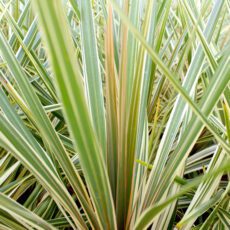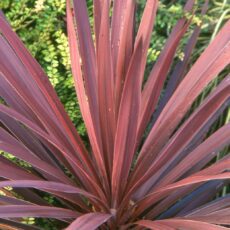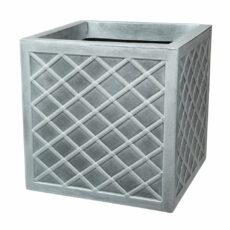Name: Cordyline spp. | Type: Evergreen | Family: Asparagaceae
Cordyline, often referred to as cabbage trees or palm lilies, is a fascinating and diverse genus of evergreen plants. These plants are native to New Zealand, Australia, Southeast Asia, and some Pacific Islands. They are a favourite in gardens and landscaping projects worldwide thanks to their striking, colourful foliage and architectural form.
Cordylines’ Appearance and Growth
Cordylines come in a delightful range of colours, including greens, reds, purples, and variegated patterns. Their long, sword-like leaves add a dramatic flair to any garden. Depending on the species and growing conditions, Cordylines can reach impressive heights of up to 15 metres (50 feet) in the wild. However, in cultivation, they usually grow to a more manageable 1-4 metres (3-13 feet).

Positioning
Cordyline plants are quite adaptable but have their preferences. They thrive in sunny or partially shaded positions and appreciate well-drained soil. While they can tolerate coastal conditions, it’s important to provide some protection in colder climates, particularly from frost and strong winds.
Cordylines are hardy in RHS hardiness rating zones H4 to H1c, making them suitable for milder climates. These plants flower in late spring to early summer, producing small, fragrant white to pale lilac flowers. Planting them in spring gives them the best start for robust growth.
Soil Type and Conditions
Cordylines are not particularly fussy about soil as long as it’s well-drained. They can thrive in sandy, loamy, and even clay soils. To give them a boost, enrich the soil with organic matter. This not only improves drainage but also provides essential nutrients for healthy growth.
Watering
Watering Cordylines is very straightforward. They prefer consistently moist soil, especially during dry periods, but be careful not to overwater as they dislike soggy roots. In the winter, when the plant’s growth slows, you can reduce the watering frequency.
Remember that if you’re using peat free compost you should check below the surface level to confirm if the compost is moist before watering.
Pruning
Pruning Cordylines is an easy activity and helps keep them looking their best. Remove any dead or damaged leaves to tidy up the plant. If you want to encourage a bushier appearance, you can trim back the main stem. The best time to prune is in the spring, just as the growing season kicks off.
About Cordylines
Cordylines are not just garden showstoppers; they have a rich cultural history. In Maori traditions, Cordyline species hold significant value, often used for their sturdy leaves in weaving and thatching. Their versatility in both wild and cultivated settings make them a beloved choice for gardeners.
Cordyline plants are generally beneficial to garden wildlife. They offer shelter and nesting sites for birds, and their flowers attract pollinators like bees and butterflies, which help to boost garden biodiversity. Rest assured; these plants do not pose any significant threat to wildlife.

Planting Ideas
The versatility of Cordylines makes them a fantastic addition to various garden styles. They add height and structure to borders and can be stunning focal points in tropical-themed gardens. Cordylines also thrive in containers, making them a great choice for patios and balconies. For a striking visual effect, pair them with contrasting plants such as ornamental grasses or colourful perennials.
View our Collection of PlantsInteresting Cordyline Facts
- Symbolic Plant: In Hawaii, the Ti plant (Cordyline fruticosa) is considered sacred to the God Lono and Goddess Laka of hula and is often planted around homes and temples for good luck and protection.
- Medicinal Uses: In traditional medicine, parts of the Cordyline plant are used for their alleged medicinal properties. For instance, some Pacific Island cultures use the leaves and roots to treat various ailments such as a high fever, and a bad cough.
- Edible Parts: The roots of some Cordyline species, particularly Cordyline australis, are edible and were historically baked or brewed into a tea as a carbohydrate source by indigenous people in New Zealand.
- Fire-Resistant Leaves: The leaves of Cordyline australis are highly fibrous and resistant to fire, which made them useful in traditional Maori society for constructing durable roofs.
- Air Purification: Like many houseplants, Cordylines are known to improve indoor air quality by removing toxins such as formaldehyde and benzene from the air.
- Pest Resistance: Cordylines are relatively pest-resistant, though they can occasionally be affected by spider mites, scale insects, or root rot if not properly cared for.









